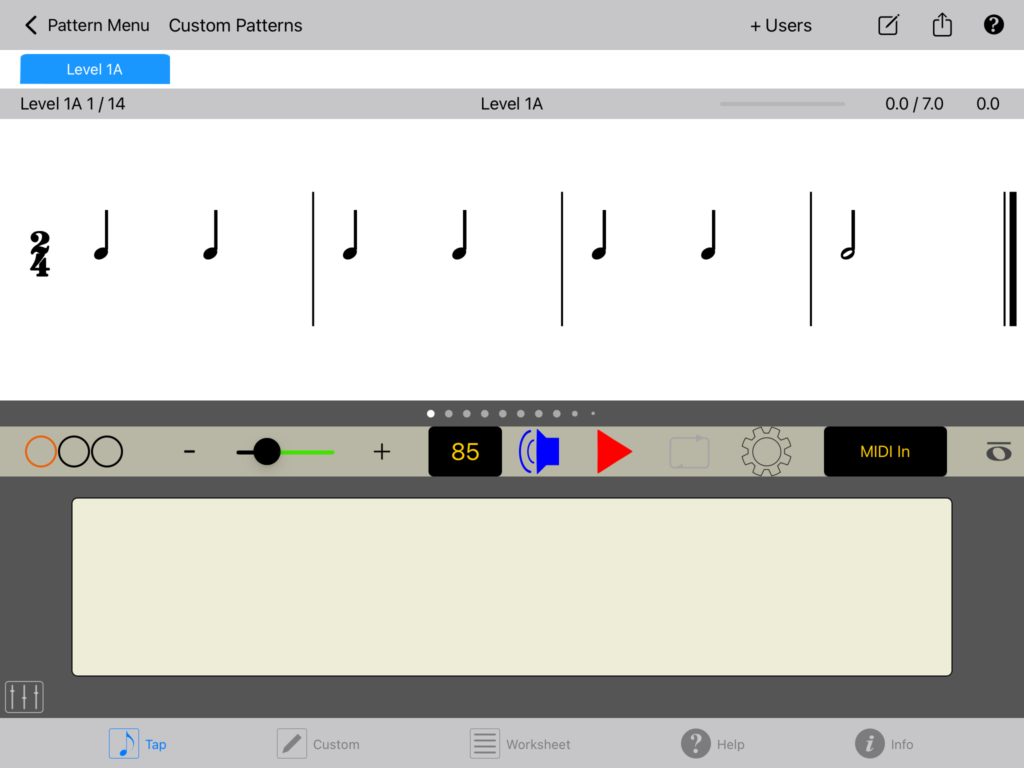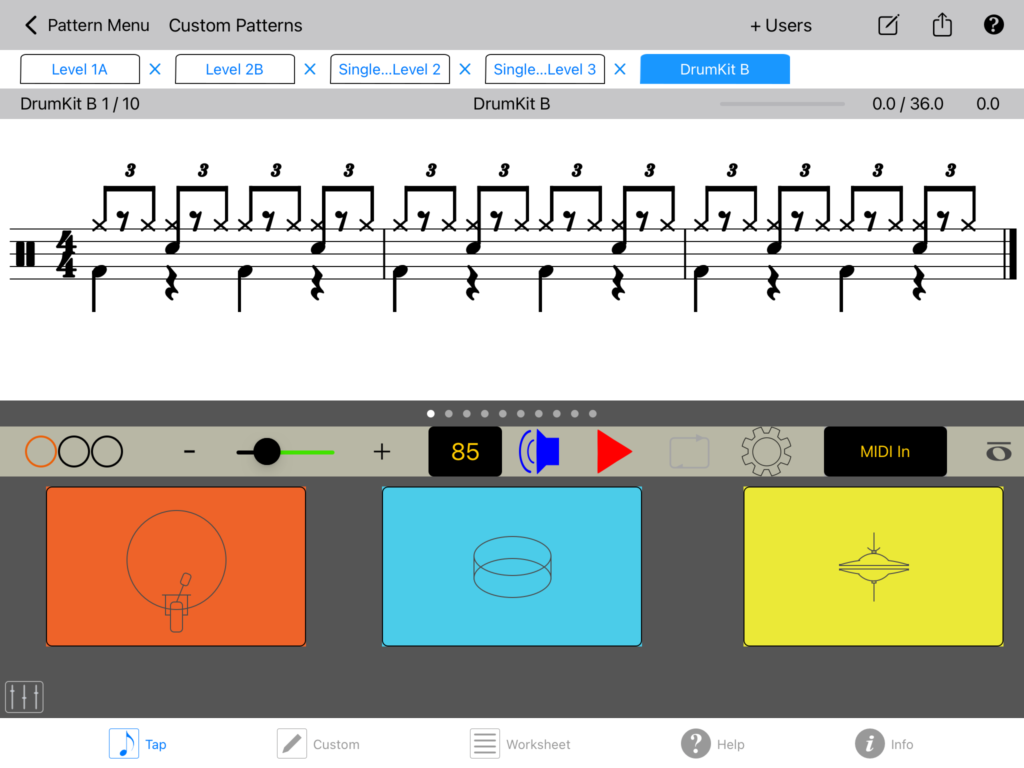#1: Rhythm Lab offers four different types of rhythm patterns.
Most rhythm apps on the App Store only present single, one-voice rhythm patterns . In real life, musicians often have to use both hands and even feet (think drummer, organist) to negotiate complex rhythm patterns.
Rhythm Lab offers four types of rhythms:








#2: Rhythm Lab covers a wide range of levels.
Rhythm Lab works great with younger students. Many beginning-level rhythms are included, and of course you can create your own very quickly and easily using the custom pattern features.
Rhythm Lab also works for advanced students and musicians. Advanced features include:
- Tuplets and tuplet variations, from duplets to 15-tuplets.
- Nested tuplets – tuplets within tuplets.
- Irregular time signatures
- Numerators from 2 to 15.
- Denominators: 2, 4, 8, 16.
- Multiple numerators (up to three), such as 3+2+3, or 5+3+4.
- Mixed time signatures. Any number of different time signatures in a pattern, limited only by the number of measures.
- Incomplete measure. The first measure can be incomplete (i.e. pickup measure) without changing time signature.
#3: Rhythm Lab uses a great-looking music font.
Rhythm Lab uses the Bravura font, a SMuFL open font designed by Daniel Spreadbury to be used with Steinberg’s Dorico Music Engraving software. It is a beautiful, well-designed font.
#4: Rhythm Lab uses sophisticated note spacing.
Many rhythm apps space the notes in a simplistic, proportional manner. Rhythm Lab uses a note-spacing algorithm similar to those used by high-end music notation programs. Rather than spacing notes with a simple proportional formula, Rhythm Lab’s algorithm considers the context and spaces the notes in a flexible way according to a logarithmic formula. Since Rhythm Lab allows for more than one rhythm simultaneously, interactions between rhythms in two or three voices must be considered, including the complexities that arise from simultaneous tuplet and cross-rhythm values. So patterns will always look natural and readable.
#5: Rhythm Lab offers many options for creating and importing custom patterns.
A Rhythm Lab user can copy any of the hundreds of included rhythm patterns and customize it, or create completely new patterns from scratch, or allow Rhythm Lab to create a completely new pattern according to parameters selected by the user. Once created and added to a custom pattern set, the pattern is immediately ready to tap on the Tap Screen.
Custom patterns can be exported to an external file in JSON format, so they can be shared with other iPads, or even edited in a text editor.
Once created, custom patterns can be uploaded to the Rhythm Lab website, where they can be downloaded into Rhythm Lab on any other iPad. Exported custom pattern sets can also be imported on other iPads from cloud services like iCloud, Google Drive, or Dropbox. They can also be shared using the standard iPad file browser (save to Files, share with AirDrop, send as email, etc.).
#6: Rhythm Lab has extensive sound, audio, and MIDI options.
Rhythm Lab provides a huge number of ways to tweak, change, and play around with sounds. Starting with the included Soundfont (FluidR3_GM by Frank Wen), which has a large number of General MIDI presets and an amazing number of drumkit presets, you can find all kinds of interesting sounds to use, both for the tap pads, and for the metronome.
In addition to the packaged Soundfont, you can load and select your own Soundfont (not all work with Rhythm Lab – must be GM-compatible and include at least one complete percussion sound bank). A good place to find Soundfonts is at the Polyphone Soundfonts page.
Rhythm Lab 4.0 also allows for MIDI input from any standard MIDI instrument, including Bluetooth MIDI devices.
Rhythm Lab is compatible with Audiobus 3.0, which is an amazing app that allows all types of audio apps to interact with each other. One cool way to use Audiobus with Rhythm Lab is to use an effects app (reverb, delay, etc) attached to Rhythm Lab inside Audiobus. This allows for all kinds of cool and unique sounds.
#7: Rhythm Lab 4.0 allows for flexible user & student progress tracking.
Add as many users as you want. There is no limit other than the limits imposed by your iPad for memory and storage.
Import and Export user files quickly and easily. User names are easily added or deleted. User groups in any configuration – from a single user, to every user added to the app – can be created and exported. Merge external user files with existing users with options to replace or merge data for individual users. User files can now be exported / imported in JSON format, which allows for more access and editing capabilities outside of Rhythm Lab itself.
For teachers, this means you can create one “master” set of users, and then export / distribute these same users in different groups, or in single-user files, to help organize your students by level, age, etc. The JSON file format allows for broad usage of the files, since it is a standard text-based data storage format.
Once a user is added and selected as the current user, all exercise scores are tracked and organized for that user. In addition to exporting that user’s data in a user file, user stats can be saved or sent by email in pdf format.
The flexible import/export features make it easy to save / backup multiple student groups, or individual students’ records. If you use an online studio management service, you can upload and download student user files to your file repository (assuming the service provides a file repository).
#8: Rhythm Lab 4.0 includes a worksheet creator.
The worksheet feature is a quick and easy way to create rhythm worksheets with up to four exercises.
Simply use the “save image for worksheet” menu item, available on the main Tap screen and on the Custom editor screen, to capture perfectly cropped images of any pattern. That image is immediately available for use in the worksheet creator.
You can create exercises with missing barlines, missing time signatures, empty measures or partially empty measures.
The drawing tool (for Apple Pencil or your finger) provides additional ways to mark up an customize the worksheet.
Rhythm Lab worksheets can be exported as PDF files.
#9: Rhythm Lab 4.0 imports MusicXML files.
MusicXML is a file format used by most music notation programs to allow sharing between applications. Rhythm Lab 4.0 can import MusicXML files, with certain limitations. Rhythm Lab grabs the first eight measures of the score, and the two topmost voices in the score. If there are voices on more than one staff, Rhythm Lab grabs the topmost voice of the top two staves. This means that MusicXML files should be created or edited with these limitations in mind before importing into Rhythm Lab. Music XML files can be used to create single or double patterns in Rhythm Lab, but not Drum or Drumkit patterns.
#10: Rhythm Lab 4.0 can be used for improvisation and creativity.
When used together with a MIDI keyboard, Rhythm Lab can facilitate real-time improv sessions. Chord charts and “rhythm lead sheets” are easy to make using the drawing tools and custom pattern editor. Rhythm Lab recognizes chords as a single “hit” when using a MIDI keyboard. The Loop function allows for extended improv sessions.
Coupled with Audiobus, Rhythm Lab can be used as a creative audio production tool. Create interesting beats inside Rhythm Lab and record them in another app, with effects provided by a third app. Or use a MIDI device to “play” Rhythm Lab and record using the Audiobus-connected apps.
